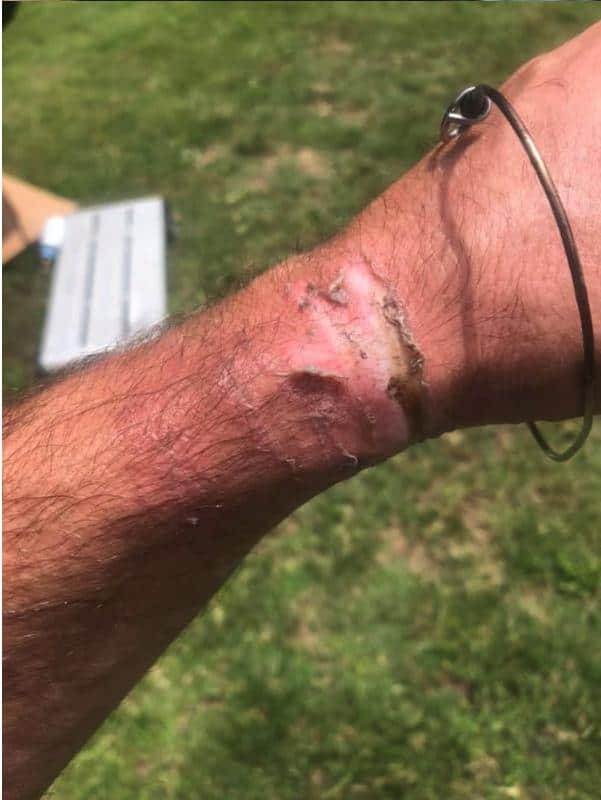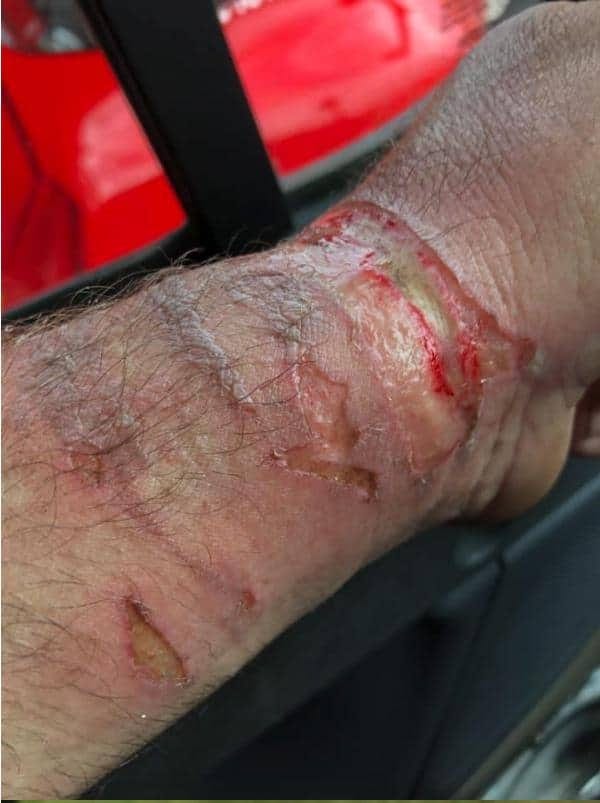RV Battery Dangers (Warning - Graphic Pictures)!
This is not for the faint of heart. These are real pictures a reader sent me of a burn he suffered from his vehicle battery ...
Dear Readers,
I see more and more of you upgrading and changing batteries in your RV. Perhaps you’re adding a second battery for more boondocking capacity, upgrading to Lithium chemistry, or simply replacing worn out batteries that no longer hold a charge. In any case, there are a lot of untrained consumers handling RV batteries without proper safety precautions.
WARNING: GRAPHIC PICTURES BELOW
Is 12 volts DC dangerous?
You bet your sweet bippy it is, but probably not for the reasons you’re thinking about. While 12-volt batteries have too low of an electrical potential to cause a dangerous electric shock like a hot-skin contact voltage, this class of batteries has the capability of supplying hundreds or even thousands of amperes of current if a metallic conductor makes contact between the plus and minus poles. And while the human body offers too high of a resistance to allow significant amperage to flow, any metal jewelry you’re wearing offers a low-resistance path that will heat up cherry red in seconds, right after it welds itself in place.
How hot can it get?
Well, if you’re unlucky enough to have your finger or hand trapped by a piece of jewelry that’s rapidly heating up due to making contact and welding itself between the battery and vehicle frame, then this chart shows you just what temperature your metal ring, watch band or bracelet achieved.
Note that if you can begin to see it glow cherry red, it’s already made it to 1,400 degrees F. And if it gets up to yellow, then you’re touching metal that’s approaching 2,000 degrees Fahrenheit.
This is a high enough temperature to cause 2nd and 3rd degree burns in seconds, then quickly begin tendon and bone damage. Yes, it’s possible to lose a finger or even a hand if you can’t break your jewelry free from the welded connection fast enough.
A real-world example
Here’s what happened to one of my RVelectricity Facebook members a few years ago that should serve as a warning to all of us. Even though he was a 25-year certified ASE mechanic and said he should have known better, he admitted to getting complacent while working around an alternator. Note that he was wearing a thin metal bracelet made from a stainless steel bicycle spoke, which you can see in the top right part of the picture.
Somehow he accidentally made contact between the main wire on the alternator and something metal in the engine compartment of his RV. Virtually every piece of metal in an RV is bonded to the frame, and the negative terminal of the batteries are also bonded to the vehicle frame. Because the alternator is connected directly to the battery via this primary wire, the current can flow either way. That allowed the full cold cranking amps of the batteries to be available to heat up that thin metal bracelet after welding itself in place.
No, it’s not a shock, it’s a burn…
While it’s true that you really can’t get shocked from a 12-volt battery (unless you can put your tongue across it, and even then it’s probably not dangerous), anything metal connecting the positive and negative battery terminals will cause hundreds of amperes of current to flow and heating to occur.
I’m sure the temperature of the bracelet reached way over 1,000 degrees F in an instant, and he tried to get it loose quickly. But since the bracelet had tack-welded itself between the alternator terminal and vehicle frame, all he could do was attempt to pull the red hot metal loose using his bare flesh. Here’s what the top of his arm looked like.
It gets worse, much worse…
You can see from the burn marks on the bottom of his arm that he had to pull on the red-hot bracelet multiple times in an attempt to free that thin piece of wire from the huge current flowing through it (probably upwards of 1,000 amperes), with the temperature continuing to rise. Stainless steel melts at around 2,700 degrees Fahrenheit, and with enough time an RV battery can probably get it up to that temperature.
Every time he tried to pulled away from it, the metal bracelet burned into his flesh even deeper. He must have been in incredible pain for the time it took to free himself from the red-hot metal bracelet. This picture shows you just how much damage a bracelet heated up by an RV battery can cause.
But he’s lucky…
This type of burn injury can not only be extremely painful, there are other hidden dangers if you short out your RV or vehicle battery. For example, it’s also possible to cause acid to boil out of a flooded-cell battery and hit you in the eye (I witnessed this happen to my dad many years ago when he got the jumper cables reversed).
Wedding rings are dangerous too
I personally witnessed a car mechanic get his wedding ring trapped between a wrench on the positive terminal of a vehicle battery and the car frame, welding itself into place.
I heard him screaming while he was trying to break free of the red-hot ring, and then saw him run to the sink in the back of the shop to submerge his hand in cold water. I could see a cloud of steam rising from the sink, attesting to just how hot the ring got.
The paramedics who transported him to the emergency room said he was lucky he didn’t lose the finger. But he did have tendon damage and never regained full use of his finger.
What can you do to stay safe?
Remove all jewelry including rings, bracelets, watches and necklaces when working around any live electrical circuits, especially batteries. Just remember that RV and vehicle batteries are ALWAYS live. Anything metal can cause a short circuit with very bad results.
Wear safety glasses when working around anything electrical. I have pictures of exploding bits of metal flying from copper wire during a short circuit that could easily put our your eye. Safety glasses are a must.
Disconnect the negative terminal of the battery first, and put it back on last. That way if your wrench accidentally makes contact with the vehicle frame, because it’s on the negative terminal of the battery there’s no voltage differential to drive the current. Once the negative terminal of the battery is removed, it’s then safe to disconnect the positive terminal. At that point, even if your wrench makes contact with the frame the battery is isolated from the chassis ground and no current can flow.
Let’s play safe out there… Mike











I am a retired auto service technician. As a young trainee, early 1980's, I was told to wear goggles when servicing batteries. I wasn't told why, so I did not wear any protection. One morning a customer dropped off their car at the front door and a few minutes later the battery exploded with a huge BOOM! We go out there and open the hood to investigate and found plastic pieces and acid all over the engine compartment. The car was just sitting there not running!! I have seen it happen one other time after Jumper cables were attached, the dead battery exploded when the key was turned to start the car. I was the one that attached the jumper cables, I had safety glasses on and my back turned. I have always kept my back toward batteries since the first explosion. People say "What are you doing?" and I tell them my back skin grows back, but, my eyes won't! People that have not seen a battery explode do not realize the danger.